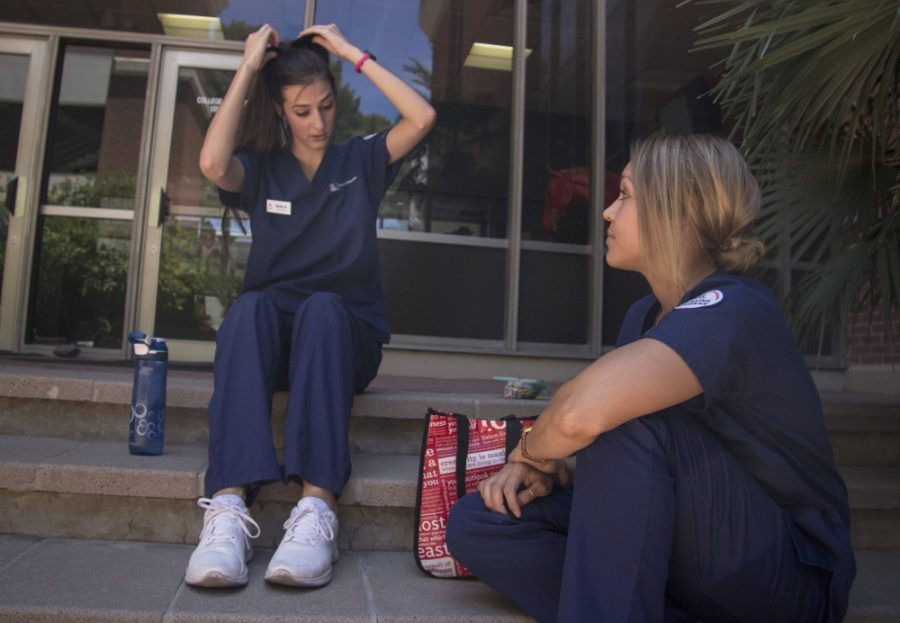Since the COVID-19 pandemic turned the world upside down in March 2020, the efforts of medical workers worldwide have had to tremendously increase in order to keep up with the growing number of patients affected by the virus. With this dramatic increase in patients, hospitals have struggled to maintain an adequate amount of both equipment and personnel to assist those in critical care.
In Arizona and around the United States, hospitals are noticing a shortage in the number of nurses available to work around the clock to care for both COVID-19 patients and those with other conditions. This creates an array of obstacles for hospitals and patients alike and can negatively impact the care that patients receive.
Virginia native Tommy Gibbons is a travel nurse, a nurse who travels from hospital to hospital helping out in temporary nursing positions, and he has seen first-hand the effects that the nursing shortage has had within hospitals all around the country. After working at a variety of different hospitals during the pandemic, Gibbons has cited that the nurse-to-patient ratios have been extremely hard to adapt to, causing some patients to not receive the amount of care and attention that they would under normal circumstances.
“[Nurses] are under a lot of stress, especially now where all of these hospitals are asking a lot of their nurses,” Gibbons said. “Right now, I work with a lot of trach vented patients. We were supposed to have one trach vent patient each, and we were having a three-to-one ratio, and now I’m getting like two trach vent patients and a four-to-one ratio.”
Trach vent patients are patients requiring a tracheostomy procedure, where a ventilator is utilized in order to help someone breathe when their air passage is blocked or contracted. These patients typically require much attention and care, due to their vulnerability and inability to breathe on their own and have seen increased numbers in hospitals since the pandemic began.
Gibbons noted that the pay rates in Arizona have influenced the number of nurses available as well, as nurses are struggling to work overtime at the same base rate as before the pandemic hit, which has influenced some nurses to search for higher pay rates elsewhere. Additionally, with the danger of working in such a contagious environment for so many hours per day, many nurses worry about the safety of both themselves and their families.
“A lot of these people are worried about their families,” Gibbons said. ”They don’t want to work in close contact with these patients, especially last year, given a virus that we weren’t 100% sure about and then taking this back with their families.”
Gibbons has personally observed how the lack of qualified personnel has influenced many hospitals to move nurses around from different units in order to fill the need of patients affected by COVID-19 related symptoms.
“It’s almost like a desperation act where they need all people on deck,” Gibbons said.
Gibbons said he believes that incoming prospects for nurses should be prepared to adapt when they enter the workforce, given the current circumstances but should also keep in mind their own safety and personal limits.
“I think that a lot of nurses are going to get a lot more responsibilities thrown at them, they’re going to get a lot more opportunities, and I think they’re honestly going to have a lot more negotiation power,” Gibbons said.
Betty Parisek, a clinical assistant professor with the University of Arizona College of Nursing and the program director of the Bachelor of Science in Nursing Integrative Health, or BSN-IH, program in Gilbert, Arizona, noted further reasons for the nursing shortage in Arizona.
Parisek stated that a significant shortage of qualified nursing faculty to teach nursing students has influenced the decrease in the number of nurses entering the ranks of hospitals every year. That coupled with the large number of nurses reaching the age of retirement has served to lessen the number of active nurses in the workforce.
As part of the curriculum with the BSN-IH program, Parisek stressed the importance of building resilience within the nursing profession, starting with the students currently on track to become registered nurses in the near future.
“The hope is that [students] are more likely to be retained in the program,” Parisek said. “We build resilience through a sense of community and offering opportunities to integrate mindfulness and integrative therapies for themselves as well.”
Parisek said she hopes that the holistic approach taught by the BSN-IH program will be a great start towards a greater number of qualified nurses in the time to come. And despite all of the challenges currently faced by nurses today, Parisek is confident that things will soon change for the better.
“The shortage has been for years coming in cycles. There was a period where we had a lot of RNs and the need was not as great, and that wasn’t that long ago,” Parisek said. “We anticipate that there will be an increase. … The RN workforce is expected to grow from 3 million in 2019 to 3.3 million in 2029.”
Though recent times have been especially tough for medical workers in hospitals around the country, there is hope from Parisek that, soon enough, the shortage of nurses will not be a factor in the care of patients who need it.
Follow Vic Verbalaitis on Twitter









